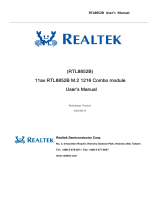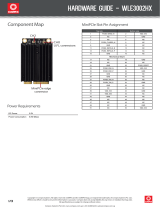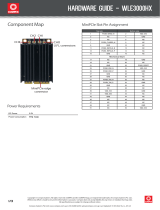
1889 (Accessory Radio) Module Setup Diagram
Dual-band wireless accessory radio

Please prepare “Windows 7 OS” Notebook
Step1. Insert Type B to PC USB & Adapter,Device Manager show
Picture,and press Mouse Right Key update,When install finish:
Before After
Setp2.Executexxx\\customer_package_UIv2.06_DLLv4.09_E2-20190402_WinDriverV.0.
0.2.5_FWv.42a1045_VIDPIDCorrected\
QATool_Dbg.exe for Start QA Tool:
==================backup======================
If driver shows exclamation mark, follow the steps to update

Step1.Check Hardware identification code
Step2.Open the safety information
Step3.Key in the Hardware identification code you got from step1

Federal Communication Commission Interference Statement
This device complies with Part 15 of the FCC Rules. Operation is subject to the following two conditions:
(1) This device may not cause harmful interference, and (2) this device must accept any interference
received, including interference that may cause undesired operation.
This equipment has been tested and found to comply with the limits for a Class B digital device, pursuant
to Part 15 of the FCC Rules. These limits are designed to provide reasonable protection against harmful
interference in a residential installation. This equipment generates, uses and can radiate radio frequency
energy and, if not installed and used in accordance with the instructions, may cause harmful interference
to radio communications. However, there is no guarantee that interference will not occur in a particular
installation. If this equipment does cause harmful interference to radio or television reception, which
can be determined by turning the equipment off and on, the user is encouraged to try to correct the
interference by one of the following measures:
- Reorient or relocate the receiving antenna.
- Increase the separation between the equipment and receiver.
- Connect the equipment into an outlet on a circuit different from that
to which the receiver is connected.
- Consult the dealer or an experienced radio/TV technician for help.
FCC Caution: Any changes or modifications not expressly approved by the party responsible for
compliance could void the user's authority to operate this equipment.
This transmitter must not be co-located or operating in conjunction with any other antenna or transmitter.
Operations in the 5.15-5.25GHz band are restricted to indoor usage only.
Radiation Exposure Statement:
This equipment complies with FCC radiation exposure limits set forth for an uncontrolled environment.
This equipment should be installed and operated with minimum distance 20cm between the radiator &
your body.

This module is intended for OEM integrators only. Per FCC KDB 996369 D03 OEM Manual v01
guidance, the following conditions must be strictly followed when using this certified module:
KDB 996369 D03 OEM Manual v01 rule sections:
2.2 List of applicable FCC rules
This module has been tested for compliance to FCC Part 15.247 & Part 15 Subpart E.
2.3 Summarize the specific operational use conditions
The module is tested for standalone mobile RF exposure use condition. Any other usage conditions
such as co-location with other transmitter(s) or being used in a portable condition will need a separate
reassessment through a class II permissive change application or new certification.
2.4 Limited module procedures
This module is limited to specific Microsoft Host, authenticated and operated by non-alterable secure
program code contained and controlled by the Host as described in the application exhibit.
2.5 Trace antenna designs
Not applicable.
2.6 RF exposure considerations
This equipment complies with FCC mobile radiation exposure limits set forth for an uncontrolled
environment. This equipment should be installed and operated with a minimum distance of 20cm
between the radiator & your body. If the module is installed in a portable host, a separate SAR
evaluation is required to confirm compliance with relevant FCC portable RF exposure rules.
2.7 Antennas
The following antennas have been certified for use with this module; antennas of the same type with equal or lower
gain may also be used with this module. The antenna must be installed such that 20 cm can be maintained between
the antenna and users.

2.8 Label and compliance information
The final end product must be labeled in a visible area with the following: “Contains FCC ID:
C3K1889”. The grantee's FCC ID can be used only when all FCC compliance requirements are met.
2.9 Information on test modes and additional testing requirements
This transmitter is tested in a standalone mobile RF exposure condition and any co-located or
simultaneous transmission with other transmitter(s) or portable use will require a separate class II
permissive change re-evaluation or new certification.
2.10 Additional testing, Part 15 Subpart B disclaimer
This transmitter module is tested as a subsystem and its certification does not cover the FCC Part 15
Subpart B (unintentional radiator) rule requirement applicable to the final host. The final host will still
need to be reassessed for compliance to this portion of rule requirements if applicable.
As long as all conditions above are met, further transmitter test will not be required. However, the
OEM integrator is still responsible for testing their end-product for any additional compliance
requirements required with this module installed.
IMPORTANT NOTE: In the event that these conditions can not be met (for example certain laptop
configurations or co-location with another transmitter), then the FCC authorization is no longer
considered valid and the FCC ID can not be used on the final product. In these circumstances, the OEM
integrator will be responsible for re-evaluating the end product (including the transmitter) and obtaining a
separate FCC authorization.
Manual Information To the End User
The OEM integrator has to be aware not to provide information to the end user regarding how to install or
remove this RF module in the user’s manual of the end product which integrates this module.
The end user manual shall include all required regulatory information/warning as show in this manual.

OEM/Host manufacturer responsibilities
OEM/Host manufacturers are ultimately responsible for the compliance of the Host and Module. The
final product must be reassessed against all the essential requirements of the FCC rule such as FCC Part
15 Subpart B before it can be placed on the US market. This includes reassessing the transmitter module
for compliance with the Radio and EMF essential requirements of the FCC rules. This module must not
be incorporated into any other device or system without retesting for compliance as multi-radio and
combined equipment
Industry Canada statement:
This device complies with ISED’s licence-exempt RSSs. Operation is subject to the following two
conditions: (1) This device may not cause harmful interference, and (2) this device must accept any
interference received, including interference that may cause undesired operation.
Le présent appareil est conforme aux CNR d’ ISED applicables aux appareils radio exempts de licence.
L’exploitation est autorisée aux deux conditions suivantes : (1) le dispositif ne doit pas produire de
brouillage préjudiciable, et (2) ce dispositif doit accepter tout brouillage reçu, y compris un brouillage
susceptible de provoquer un fonctionnement indésirable.
Radiation Exposure Statement:
This equipment complies with ISED radiation exposure limits set forth for an uncontrolled environment.
This equipment should be installed and operated with greater than 20cm between the radiator & your
body.
Déclaration d'exposition aux radiations:
Cet équipement est conforme aux limites d'exposition aux rayonnements ISED établies pour un
environnement non contrôlé. Cet équipement doit être installé et utilisé à plus de 20 cm entre le
radiateur et votre corps.
This device is intended only for OEM integrators under the following conditions: (For module device use)
1) The antenna must be installed and operated with greater than 20cm between the antenna and users,
and
2) The transmitter module may not be co-located with any other transmitter or antenna.
As long as 2 conditions above are met, further transmitter test will not be required. However, the OEM
integrator is still responsible for testing their end-product for any additional compliance requirements

required with this module installed.
Cet appareil est conçu uniquement pour les intégrateurs OEM dans les conditions suivantes: (Pour
utilisation de dispositif module)
1) L'antenne doit être installé et exploité avec plus de 20 cm entre l'antenne et les utilisateurs, et
2) Le module émetteur peut ne pas être coïmplanté avec un autre émetteur ou antenne.
Tant que les 2 conditions ci-dessus sont remplies, des essais supplémentaires sur l'émetteur ne seront
pas nécessaires. Toutefois, l'intégrateur OEM est toujours responsable des essais sur son produit final
pour toutes exigences de conformité supplémentaires requis pour ce module installé.
IMPORTANT NOTE:
In the event that these conditions can not be met (for example certain laptop configurations or
co-location with another transmitter), then the Canada authorization is no longer considered valid and
the IC ID can not be used on the final product. In these circumstances, the OEM integrator will be
responsible for re-evaluating the end product (including the transmitter) and obtaining a separate
Canada authorization.
NOTE IMPORTANTE:
Dans le cas où ces conditions ne peuvent être satisfaites (par exemple pour certaines configurations
d'ordinateur portable ou de certaines co-localisation avec un autre émetteur), l'autorisation du Canada
n'est plus considéré comme valide et l'ID IC ne peut pas être utilisé sur le produit final. Dans ces
circonstances, l'intégrateur OEM sera chargé de réévaluer le produit final (y compris l'émetteur) et
l'obtention d'une autorisation distincte au Canada.
End Product Labeling
This transmitter module is authorized only for use in device where the antenna may be installed and
operated with greater than 20cm between the antenna and users. The final end product must be labeled
in a visible area with the following: “Contains IC: 3048A-1889”.
Plaque signalétique du produit final
Ce module émetteur est autorisé uniquement pour une utilisation dans un appareil où l’antenne peut
être installée et utilisée à plus de 20 cm entre l’antenne et les utilisateurs. Le produit final doit être
étiqueté dans un endroit visible avec l'inscription suivante: "Contient des IC: 3048A-1889".
Manual Information To the End User

The OEM integrator has to be aware not to provide information to the end user regarding how to install
or remove this RF module in the user’s manual of the end product which integrates this module.
The end user manual shall include all required regulatory information/warning as show in this manual.
Manuel d'information à l'utilisateur final
L'intégrateur OEM doit être conscient de ne pas fournir des informations à l'utilisateur final quant à la
façon d'installer ou de supprimer ce module RF dans le manuel de l'utilisateur du produit final qui
intègre ce module.
Le manuel de l'utilisateur final doit inclure toutes les informations réglementaires requises et
avertissements comme indiqué dans ce manuel.
Caution :
(i) the device for operation in the band 5150-5250 MHz is only for indoor use to reduce the potential for
harmful interference to co-channel mobile satellite systems;
(ii)
for devices with detachable antenna(s), the maximum antenna gain permitted for devices in the band
5725-5850 MHz shall be such that the equipment still complies with the e.i.r.p. limits as appropriate;
(iii) where applicable, antenna type(s), antenna models(s), and worst-case tilt angle(s) necessary to
remain compliant with the e.i.r.p. elevation mask requirement set forth in section 6.2.2.3 shall be clearly
indicated.
Avertissement:
(i) les dispositifs fonctionnant dans la bande 5150-5250 MHz sont réservés uniquement pour une
utilisation à l’intérieur afin de réduire les risques de brouillage préjudiciable aux systèmes de satellites
mobiles utilisant les mêmes canaux;
(ii) pour les dispositifs munis d’antennes amovibles, le gain maximal d’antenne permis (pour les
dispositifs utilisant la bande de 5 725 à 5 850 MHz) doit être conforme à la limite de la p.i.r.e. spécifiée,
selon le cas;
(iii) lorsqu’il y a lieu, les types d’antennes (s’il y en a plusieurs), les numéros de modèle de l’antenne et
les pires angles d’inclinaison nécessaires pour rester conforme à l’exigence de la p.i.r.e. applicable au
masque d’élévation, énoncée à la section 6.2.2.3, doivent être clairement indiqués.
NCC 警語

1. 第十二條 經型式認證合格之低功率射頻電機,非經許可,公司、商號或使用者均不得
擅自變更頻率、加大功率或變更原設計之特性及功能。
2. 第十四條 低功率射頻電機之使用不得影響飛航安全及干擾合法通信;經發現有干擾現
象時,應立即停用,並改善至無干擾時方得繼續使用。
前項合法通信,指依電信法規定作業之無線電通信。
低功率射頻電機須忍受合法通信或工業、科學及醫療用電波輻射性電機設備之干擾。
3. 使用此產品時應避免影響附近雷達系統之操作。
4. 系統廠商應於平台上標示「本產品內含射頻模組: CCXXXXYYyyyZzW』字樣。
-
 1
1
-
 2
2
-
 3
3
-
 4
4
-
 5
5
-
 6
6
-
 7
7
-
 8
8
-
 9
9
-
 10
10
dans d''autres langues
Documents connexes
Autres documents
-
Savant PUU-CAMIDWDPHD1 Manuel utilisateur
-
Delta NSW1000-BLE Manuel utilisateur
-
 Realtek RTL8852B M.2 1216 Combo Module Manuel utilisateur
Realtek RTL8852B M.2 1216 Combo Module Manuel utilisateur
-
Dell RFID 13.56MHz Wireless Module Mode d'emploi
-
Honeywell BTM1 Mode d'emploi
-
Pax Technology L1400 Manuel utilisateur
-
Silex technology SX-PCEAX Manuel utilisateur
-
 Compex WLE1216VX WiFi 5 4×4 MU MIMO Dual Band Module Mode d'emploi
Compex WLE1216VX WiFi 5 4×4 MU MIMO Dual Band Module Mode d'emploi
-
 Compex WLE1216VX Dual Band Module Manuel utilisateur
Compex WLE1216VX Dual Band Module Manuel utilisateur
-
Omega MOD16370915 Sub-1G Module Mode d'emploi












